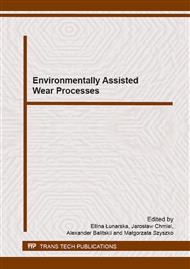[1]
Standard Test Method for Cavitation Erosion Using Vibratory Apparatus ASTM G32 - 10, Philadelphia, n. d.
Google Scholar
[2]
Standard Test Method for Erosion of Solid Materials by a Cavitating Liquid Jet, ASTM G134 - 95(2010), Philadelphia, n. d.
Google Scholar
[3]
J. Steller, International cavitation erosion test and quantitative assessment of material resistance to cavitation, in: Wear, Elsevier Sequoia SA, 1999: p.51–64.
DOI: 10.1016/s0043-1648(99)00195-7
Google Scholar
[4]
Wade E.H.R., C.M. Preece, Cavitation erosion of iron and steel, Metall. Trans. A. 9A (1978) 1299–1309.
Google Scholar
[5]
T. Okada, Y. Iwai, A. Yamamoto, A study of cavitation erosion of cast iron, Wear. 84 (1983) 297–312.
DOI: 10.1016/0043-1648(83)90271-5
Google Scholar
[6]
W.J. Tomlinson, M.G. Talks, Erosion and corrosion of cast iron under cavitation conditions, Tribol. Int. 24(2) (1991) 67–75.
DOI: 10.1016/0301-679x(91)90035-8
Google Scholar
[7]
S. Hattori, T. Kitagawa, Analysis of cavitation erosion resistance of cast iron and nonferrous metals based on database and comparison with carbon steel data, Wear. 269 (2010) 443 – 448.
DOI: 10.1016/j.wear.2010.04.031
Google Scholar
[8]
A. Al-Hashem, A. Abdullah, W. Riad, Cavitation corrosion of nodular cast iron (NCI) in seawater: microstructural effects, Mater. Charact. 47 (2001) 383–388.
DOI: 10.1016/s1044-5803(02)00185-7
Google Scholar
[9]
M. Dojcinovic, O. Eric, D. Rajnovic, L. Sidanin, S. Balos, The morphology of ductile cast iron surface damaged by cavitation, Metall. Mater. Eng. 18 (2012) 165–176.
Google Scholar
[10]
J. Chmiel, J. Steller, A. Krella, W. Janicki, Badania zużycia korozyjno-kawitacyjnego na stanowisku wibracyjnym ze spoczywająca próbką, Probl. Eksploat. 1 (2010) 91–100.
Google Scholar
[11]
J. Chmiel, E. Łunarska, Effect of Cavitation on Absorption and Transport of Hydrogen in Iron, Solid State Phenom. 183 (2012) 25–30.
Google Scholar
[12]
Z. Cui, H. Man, F. Cheng, T. Yue, Cavitation erosion–corrosion characteristics of laser surface modified NiTi shape memory alloy, Surf. Coatings Technol. 162 (2003) 147–153.
DOI: 10.1016/s0257-8972(02)00399-7
Google Scholar
[13]
C.T. Kwok, F.T. Cheng, H.C. Man, Synergistic effect of cavitation erosion and corrosion of various engineering alloys in 3 . 5 % NaCl solution, 290 (2000) 145–154.
DOI: 10.1016/s0921-5093(00)00899-6
Google Scholar
[14]
A. Al-Hashem, W. Riad, The role of microstructure of nickel–aluminium–bronze alloy on its cavitation corrosion behavior in natural seawater, Mater. Charact. 48 (2002) 37–41.
DOI: 10.1016/s1044-5803(02)00196-1
Google Scholar
[15]
J. Chmiel, D. Zasada, Crystallographic conditions for the initiation of cavitation erosion in CuMn11Al11 bronze, 33 (2008) 21–28.
Google Scholar
[16]
G.A. Schmitt, W. Buecken, R. Fanebust, Modeling microturbulences at surface imperfections as related to flow-induced localized corrosion, Corrosion. 48 (1992) 431–440.
DOI: 10.5006/1.3315957
Google Scholar
[17]
M. Matsumura, An Introduction to Flow Induced Macro-Cell Corrosion, Bentham Books, (2012).
Google Scholar
[18]
M. Arora, C. -D. Ohl, K. Mørch, Cavitation Inception on Microparticles: A Self-Propelled Particle Accelerator, Phys. Rev. Lett. 92 (2004) 174501.
DOI: 10.1103/physrevlett.92.174501
Google Scholar


